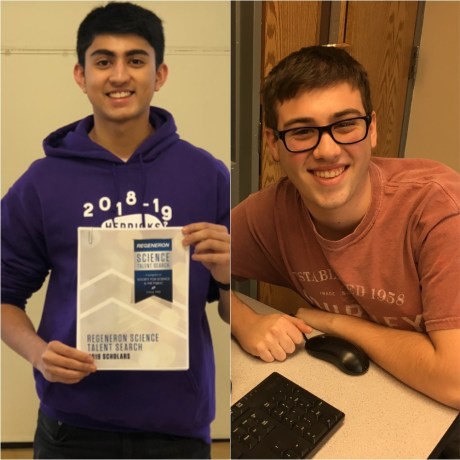One day, 18-year-old Justin Schiavo said, he wants to be behind the first manned mission to Mars.
“My career goals are very unrealistic but very optimistic,” the Roslyn High School student said. “I want to be part of the story that makes humans an interplanetary species.”
He has already taken steps toward that goal, one of which experts in the field have deemed an achievement by selecting him as one of the top 40 students in a nationwide science competition.
Schiavo and Herricks High School’s Eish Maheshwari were two of five Long Island teens to be named among the nation’s 40 finalists in the Regeneron Science Talent Search. For the competition, Schiavo designed small rockets with different nozzles and tested how they compared.
Schiavo and Maheshwari will take their projects to Washington, D.C., in March, where they will compete for one of 10 scholarship awards ranging from $40,000 to $250,000. Regardless of whether they make it into the final 10, both students will earn at least $25,000 toward their college educations.
Schiavo’s interest in space dates back to his early childhood, he said. He’s read books and studies and watched videos about “almost every space topic imaginable.”
“He really has a love of all things related to space and always has,” said Allyson Weseley, the coordinator of Roslyn High School’s research program.
For his project submission, Schiavo wanted to test ways to increase the thrust of a hybrid rocket engine.
His hypothesis was that a different nozzle shape would make the rocket go further, so he tested one with an aerospike-shaped nozzle against the engine’s typical bell nozzle.
He designed the nozzles and printed them on a 3D printer, and tested it in the garage of his father’s heating and air conditioning company.
The first time, the arrow spike nozzle melted. But after redesigning it to include a cooling system, Schiavo proved his hypothesis.
“I think maybe one of the biggest problems in our society today is that learning has become a chore,” he said. “Curiosity is built into our DNA.”
Schiavo makes annual elementary school classroom visits to teach first-graders about space, and last week visited his fifth-grade brother’s class and got to go into the details of his experiment, he said.
Maheshwari’s project, according to science research teacher and adviser Renee Barcia, utilizes a nano-particle system to deliver vital drugs to the body that are often metabolized by the liver too quickly to be administered.
Barcia has known Maheshwari for four years, and said that he was been “something special” since she met him.
“He’s able to grasp high-level concepts,” Barcia said.
Maheshwari reached out to several institutions in the area to allow him to perform his lab work, using two milliliters of rat blood to perform his experiment: delivering a drug to its target in a body without being broken down in transit, according to Barcia.
Eventually Maheshwari chose the Albert Einstein College of Medicine in the Bronx, and he said he has been thankful for the chance to conduct his work there.
“To be named a Regeneron scholar has been very humbling,” Maheshwari said.

